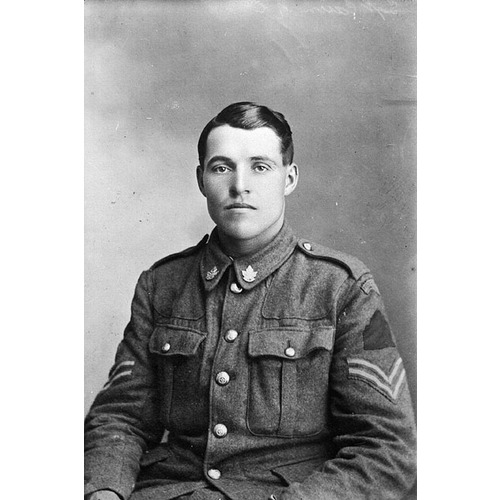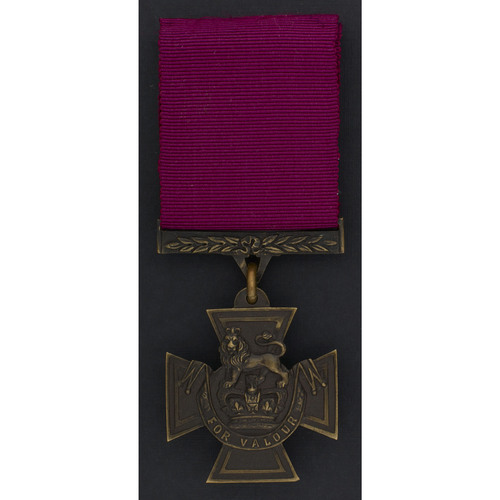CAIRNS, HUGH, soldier; b. 4 Dec. 1896 in Ashington, Northumberland, England, third of the eleven children of George Henry Cairns and Elizabeth Dotes Donkin; d. unmarried 2 Nov. 1918 near Valenciennes, France.
Hugh Cairns was educated in England prior to emigrating to Saskatchewan with his family in May 1911. An apprentice with the Northern Plumbing Company of Saskatoon, Cairns was also a member of the Christ Church choir and its football team. Contemporaries remembered him as “a chunky chap about five foot eight, one hundred and seventy pounds, ruddy of cheek.”
On 2 Aug. 1915 Hugh and his elder brother, Albert, enlisted in the 65th Infantry Battalion of the Canadian Expeditionary Force at Saskatoon. After arriving in Bramshott, England, on 29 June 1916, they were transferred the next day to the 46th Infantry Battalion, soon to depart for France. The following spring, on 3 June, Cairns led a party forward at a critical time and supplied supporting fire to the flank of a battalion attacking enemy lines near La Coulotte, close to Avion. Despite being wounded, he covered his group’s subsequent withdrawal until his ammunition was expended before making his way back to his lines. Cairns was awarded the Distinguished Conduct Medal for “conspicuous gallantry and devotion to duty.” He served with the battalion during the battles of Hill 70 in August 1917, Passchendaele in November 1917, and Amiens in August 1918. He was promoted corporal and then sergeant.
Albert’s death on 10 Sept. 1918 from wounds suffered at the taking of the Drocourt-Quéant Line profoundly affected Hugh. The brothers had been inseparable, and one of Hugh’s comrades recalled that “Hughie said he’d get fifty Germans for that” and added, “I don’t think he ever planned to come back after Abbie got killed.” Only Cairns’s almost fanatical desire to avenge his brother’s death can explain his actions eight weeks later.
On 1 Nov. 1918 Cairns’s platoon, while advancing on Marly, a suburb of Valenciennes, came under heavy enemy machine-gun fire. He seized a Lewis machine-gun and rushed the post, killing 5 Germans and capturing the gun. A short time later the platoon once more encountered enemy resistance. Again Cairns launched a one-man assault, killing 12 and capturing 18 and two more machine-guns. For a third time the advance was checked. Although wounded, Cairns led a small party to outflank the German force. The group killed a number and captured approximately 50 soldiers and their weaponry.
Despite these superhuman accomplishments, Cairns’s day was not done. After the Canadian line east of Valenciennes had been consolidated, he accompanied a small patrol in Marly. There it trapped and forced the surrender of 60 enemy soldiers. While the captives were being disarmed, a German officer shot Cairns in the abdomen. The patrol returned fire, inflicting heavy casualties. During the battle Cairns collapsed from loss of blood. He died of his wounds on 2 November, nine days before the armistice, and is buried in Auberchicourt British Cemetery, east of Douai, France.
In a letter to Cairns’s mother, Chaplain F. H. Buck said, “Your son was by all odds one of the outstanding men in the battalion. He simply did not know what fear was and his skill with a machine gun could not be surpassed.” In recognition of his “most conspicuous bravery” Cairns was posthumously awarded the Victoria Cross, the last given to a Canadian for World War I. The medal was presented to his father in April 1919. Cairns was also named a chevalier of the Legion of Honour by the government of France. He was recognized further by the town of Valenciennes, which in 1936 named an avenue after him. This avenue is the only one in France to be named after an ordinary soldier from a foreign country. At Saskatoon, besides a statue of him commemorating football players killed during the war, tributes to Cairns include a school and an armoury named in his honour. He has come to symbolize the Great War for the inhabitants of the city.
General Register Office, Northumberland Central Registration Dist. (Morpeth, Eng.), Reg. of births, Bedlington, 4 Dec. 1896. NA, RG 150, Acc. 1992–93/166, file 472168. Daily Star (Saskatoon), November 1918–May 1919. The epic of Vimy, ed. W. W. Murray (Ottawa, [1936]). Don Kerr and S. [D.] Hanson, Saskatoon: the first half-century (Edmonton, 1982) (photo of Cairns on p.158). J. L. McWilliams and R. J. Steel, The suicide battalion (Edmonton, 1978). G. G. Nasmith, Canada’s sons and Great Britain in the World War . . . (Toronto, 1919). Valiant men: Canada’s Victoria Cross and George Cross winners, ed. John Swettenham (Toronto, 1973).
Cite This Article
Stanley D. Hanson, “CAIRNS, HUGH,” in Dictionary of Canadian Biography, vol. 14, University of Toronto/Université Laval, 2003–, accessed May 15, 2025, https://www.biographi.ca/en/bio/cairns_hugh_14E.html.
The citation above shows the format for footnotes and endnotes according to the Chicago manual of style (16th edition). Information to be used in other citation formats:
| Permalink: | https://www.biographi.ca/en/bio/cairns_hugh_14E.html |
| Author of Article: | Stanley D. Hanson |
| Title of Article: | CAIRNS, HUGH |
| Publication Name: | Dictionary of Canadian Biography, vol. 14 |
| Publisher: | University of Toronto/Université Laval |
| Year of revision: | 1998 |
| Access Date: | May 15, 2025 |





